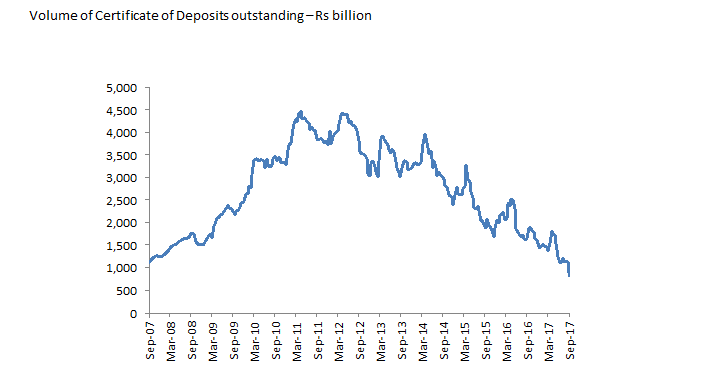Certificate of Deposits fall below Rs 1 lakh crore for the first time in a decade
Performance in Certificate in deposits have decline by nearly 60% in September 2017. Such decline was on the back of weak credit growth from banks, surge in deposit base post demonetisation.

Certificate of Deposits (CDs) have fallen under Rs 1 lakh crore for the first time in the last decade.
Data provided by ICRA show that outstanding CD volume declined by 59.60% to Rs 82,400 crore as on September 15, 2017 -- a level last seen in September 2007.
Outstanding CD volume stood at Rs 2.04 lakh crore in the corresponding month of the previous year.

Performance of CD volume increased from Rs 1 lakh crore in 2007 to Rs 3.5 lakh crore in the year 2010 and reached an all-time high of over Rs 4.5 lakh crore in 2012.
Karthik Srinivasan, Group Head - Financial Sector Ratings, ICRA Limited, said, “With weak credit growth from the banking sector and surge in deposit base post demonetisation, the banks’ reliance on borrowing through CDs has been gradually declining."
A Certificate of Deposit (CD) is a money market instrument which has been in existence since 1989. They are issued in a dematerialised form against funds deposited in a bank for a specific period.
The Reserve Bank of India (RBI) issues guidelines for Certificate of Deposit from time to time.
CDs can only be issued for a minimum of Rs 1 lakh by a single issuer and in multiples of Rs 1 lakh.
Maturity period for a CD issued by banks is not less then seven days and not above one year, while for financial institutions maturity period should not be issued for less than 1 year and not above three years.
Srinivasan added, "With recent reduction in statutory liquidity ratio by RBI from 20.0% to 19.5% and expectations of 7-8% credit growth of the banking sector, the CD volumes are expected to remain subdued.”
RBI in October 2017 monetary policy reduced the Statutory Liquidity Ratio (SLR) by 50 basis points to 19.50% from previous 20%.
Along with this, the ceiling on SLR securities under ‘Held to Maturity’ (HTM) will also be reduced by 50 basis point from 20.25% to 19.50% of banks' NDTL in a phased manner - which is 20% by December 31, 2017 and 19.50% by March 31, 2018.
Apart from Cash Reserve Ratio (CRR), banks are needed to hold a certain percentage of NDTL in forms of securities like government bonds, gold, cash, etc.
This certain portion is called as SLR – which is done to ensure banks have enough of funds available to pay back to its customers who may have any immediate requirement to encash their deposits.
RBI said, "Surplus liquidity in the system persisted through Q2 even as the build-up in government cash balances since mid-September 2017 due to advance tax outflows reduced the size of the surplus liquidity significantly in the second half of the month."
Data provided by RBI highlighted net average absorption of liquidity under the LAF declined from Rs 3 lakh crore in July to Rs 1.6 lakh crore in the second half of September.
On year-on-year basis, credit growth of banks stood lower at 7.5% as against y-o-y deposit growth of 10.0%.
It is important to note that banks have to maintain the SLR and CRR on the price of a Certificate of Deposit.
Get Latest Business News, Stock Market Updates and Videos; Check your tax outgo through Income Tax Calculator and save money through our Personal Finance coverage. Check Business Breaking News Live on Zee Business Twitter and Facebook. Subscribe on YouTube.
RECOMMENDED STORIES

Looking for short term investment ideas? Analysts suggest buying these 2 stocks for potential gain; check targets

Rs 3,500 Monthly SIP for 35 years vs Rs 35,000 Monthly SIP for 16 Years: Which can give you higher corpus in long term? See calculations
05:18 PM IST










 Will banks be forced to sharply hike their deposit rates in coming months? Icra Ratings report says this
Will banks be forced to sharply hike their deposit rates in coming months? Icra Ratings report says this